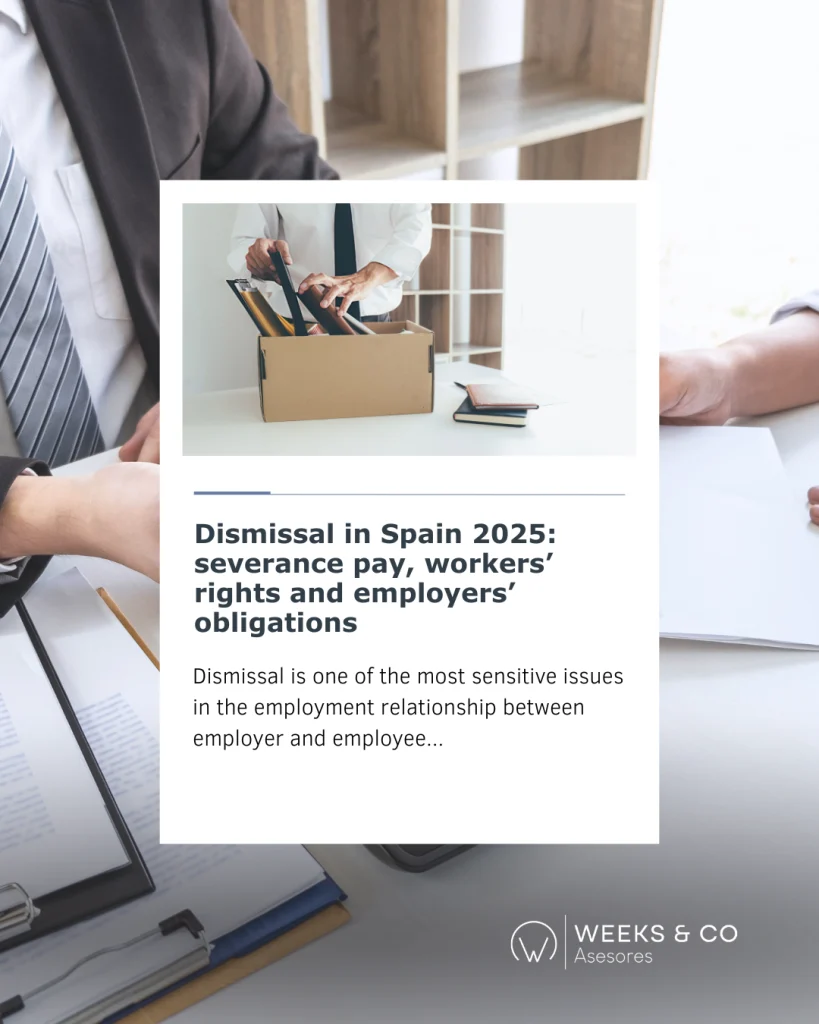Dismissal in Spain 2025: severance pay, workers’ rights and employers’ obligations

C. Herradores, 90, 1ª planta, 38202 La Laguna, Santa Cruz de Tenerife info@weeksasesores.com 922 98 22 35 Linkedin-in Instagram Facebook Home Canary Island ZEC Zone Services Weeks & Co Contact Home Canary Island ZEC Zone Services Weeks & Co Contact Contactar Dismissal in Spain 2025: severance pay, workers’ rights and employers’ obligations On the Weeks & Co Asesores Blog, we break it all down for you ⬇️ Dismissal is one of the most sensitive issues in the employment relationship between employer and employee. Spanish labour law seeks to strike a balance between protecting employees’ rights and setting out employers’ obligations, creating a legal framework that regulates how employment termination must be carried out. This article provides an updated and comprehensive guide for 2025, covering severance pay, employee rights, and employer responsibilities in dismissal cases. 1. Definition of dismissal under Spanish labour law Dismissal is the unilateral decision by the employer to terminate the employment relationship. For it to be valid, it must follow the legal procedures, be grounded in just cause, and comply with established timeframes and formalities. 2. Types of dismissal recognised in Spain 2.1. Disciplinary dismissal This arises when an employee seriously and wilfully breaches their duties (e.g. repeated unjustified absences, insubordination, or offensive conduct). It does not entitle the employee to severance pay, but they are still entitled to the final settlement. 2.2. Objective dismissal Grounded in economic, technical, organisational, or production-related reasons. Employees are entitled to 20 days’ salary per year of service, capped at 12 months’ pay 2.3. Collective dismissal Affects a significant number of employees and requires a specific Redundancy Procedure (ERE in Spanish law) 2.4. Unfair dismissal Declared when the employer fails to justify the dismissal or does not comply with legal requirements. The employee is entitled to 33 days’ salary per year of service (or 45 days for service prior to 2012), capped at 24 months’ pay 2.5. Null dismissal Occurs when the dismissal breaches fundamental rights (e.g. discrimination, maternity, or paternity). In such cases, the employee must be reinstated with back pay 3. Fundamental rights of employees in cases of dismissal 3.1. Right to information and written communication The dismissal letter must clearly state the reasons, the effective date, and the type of dismissal. 3.2. Right to severance pay (when applicable) Depending on the type of dismissal, employees may be entitled to financial compensation 3.3. Right to unemployment benefits If sufficient contributions have been made, employees may apply for unemployment support through the SEPE 3.4. Right to challenge the dismissal Employees can take legal action if they believe the dismissal is unjustified or unlawful 4. Employers’ obligations when carrying out a dismissal 4.1. Delivery of dismissal letter It must be provided in writing and contain all relevant details 4.2. Payment of settlement and severance Employers must pay all outstanding amounts (salary, unused holidays, pro-rata bonuses) 4.3. Social security contributions and notification to SEPE The employer must notify the authorities and provide documentation enabling the employee to claim unemployment benefits 5. How to calculate severance pay in 2025 5.1. General formula Severance is calculated by multiplying the number of days’ salary per year of service according to the type of dismissal. 5.2. Differences between objective and unfair dismissal Objective: 20 days per year of service, capped at 12 months. Unfair: 33 days per year of service, capped at 24 months. 5.3. Legal limits and caps Even if the calculation is high, the law imposes a maximum number of months’ pay 6. The role of the settlement (“finiquito”) in dismissal 6.1. Items included in the settlement Outstanding wages Unused holidays Pro-rata bonuses 6.2. Difference between settlement and severance pay The settlement is always due, regardless of the type of dismissal. Severance pay, however, depends on the grounds for dismissal. 7. Procedure to challenge a dismissal 7.1. 20 working-day deadline Employees have this period to file a claim. 7.2. Prior conciliation before the SMAC Before going to court, both parties must attempt to reach an agreement before the Mediation, Arbitration, and Conciliation Service 7.3. Judicial claim If conciliation fails, the case proceeds to the labour courts 8. Recent labour law changes up to 2025 8.1. Digitalization of procedures An increasing number of procedures, such as SEPE notifications and claims, are now processed online 8.2. Strengthening of collective rights Recent labour reforms have enhanced protections in cases of collective dismissal and discrimination. 9. Consequences for employers in case of non-compliance 9.1. Administrative sanctions Failure to comply with dismissal regulations may lead to fines. 9.2. Judicial and reputational costs In addition to higher severance costs, companies may face reputational damage and loss of employee trust 10. Practical advice for dismissed employees 10.1. Review the letter and settlement Check that all details and amounts are accurate 10.2. Seek legal advice A labour lawyer can identify irregularities and safeguard your rights 10.3. Apply for unemployment benefits Applications must be submitted to SEPE within 15 working days of dismissal Conclusion Dismissal, though often difficult, is regulated by a robust legal framework designed to protect workers from unfair practices. Understanding the types of dismissal, severance calculations, and the procedures for contesting a termination is crucial in 2025, both for employees and employers. Properly managing dismissal helps to reduce disputes, avoid sanctions, and maintain dignity in the workplace FAQs 1. Am I always entitled to severance pay if I am dismissed? No. In disciplinary dismissal, for example, only the settlement is paid, not severance 2. How long do I have to challenge an unfair dismissal? 20 working days from the effective date of dismissal. 3. Does the settlement include severance pay? No. The settlement covers outstanding payments, whereas severance is compensation for job loss 4. Can I claim unemployment benefits if I resign voluntarily? No. Unemployment benefits are only available in cases of dismissal or contract termination 5. What happens if the employer fails to provide a dismissal letter? The dismissal may be deemed unfair due to procedural defects Weeks & Co: Asesoría contable, fiscal, laboral y digital presencial en
